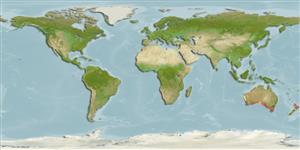Environment: milieu / climate zone / depth range / distribution range
Ecology
Marine; reef-associated; depth range ? - 60 m (Ref. 9563). Temperate
Eastern Indian to Western Pacific: in the southern coasts of Australia.
Size / Weight / Age
Maturity: Lm ? range ? - ? cm
Max length : 120 cm TL male/unsexed; (Ref. 9563)
Dorsal
spines
(total): 15 - 16;
Dorsal
soft rays
(total): 24-26;
Anal
spines: 3;
Anal
soft rays: 9 - 10. This species is distinguished by the following set of characters: D XV-XVI, 24-26; A III, 9-10; pectoral-fin rays 14 with ventral 5 unbranched and thickened; lateral�li ne scales 45-55; height of the soft dorsal fin is roughly equal to height of the spinous portion; elongated body with shallow dorsal head profile; body cylindrical in cross section; scales cycloid and large on body; eyes moderate in size; no bone processes on frontal bones or maxilla (Ref. 120445).
Found in seagrass beds and near rocky outcrops (Ref. 9563). Feeds on polychaetes, isopods, amphipods and brown algae. Flesh of smaller fish is excellent eating, but its quality deteriorates with age (Ref. 2156).
Life cycle and mating behavior
Maturity | Reproduction | Spawning | Eggs | Fecundity | Larvae
May, J.L. and J.G.H. Maxwell, 1986. Trawl fish from temperate waters of Australia. CSIRO Division of Fisheries Research, Tasmania. 492 p. (Ref. 9563)
IUCN Red List Status (Ref. 130435)
Threat to humans
Harmless
Human uses
Fisheries: minor commercial
More information
Common namesSynonymsMetabolismPredatorsEcotoxicologyReproductionMaturitySpawningSpawning aggregationFecundityEggsEgg development
ReferencesAquacultureAquaculture profileStrainsGeneticsElectrophoresesHeritabilityDiseasesProcessingNutrientsMass conversion
Tools
Special reports
Download XML
Internet sources
Estimates based on models
Preferred temperature (Ref.
123201): 14.4 - 20.9, mean 17.5 °C (based on 174 cells).
Phylogenetic diversity index (Ref.
82804): PD
50 = 1.0000 [Uniqueness, from 0.5 = low to 2.0 = high].
Bayesian length-weight: a=0.00389 (0.00180 - 0.00842), b=3.12 (2.94 - 3.30), in cm total length, based on all LWR estimates for this body shape (Ref.
93245).
Trophic level (Ref.
69278): 2.9 ±0.38 se; based on food items.
Resilience (Ref.
120179): Very Low, minimum population doubling time more than 14 years (Preliminary K or Fecundity.).
Fishing Vulnerability (Ref.
59153): High to very high vulnerability (72 of 100).
Nutrients (Ref.
124155): Calcium = 8.04 [3.43, 16.08] mg/100g; Iron = 0.148 [0.075, 0.264] mg/100g; Protein = 18.7 [16.8, 20.8] %; Omega3 = 0.169 [0.085, 0.327] g/100g; Selenium = 11.6 [4.9, 26.8] μg/100g; VitaminA = 30.1 [6.7, 131.3] μg/100g; Zinc = 0.562 [0.357, 0.873] mg/100g (wet weight);
